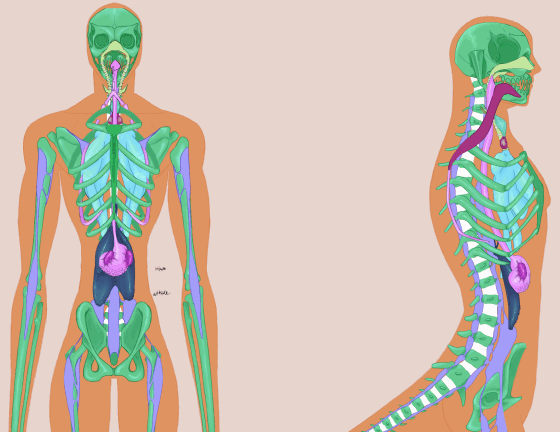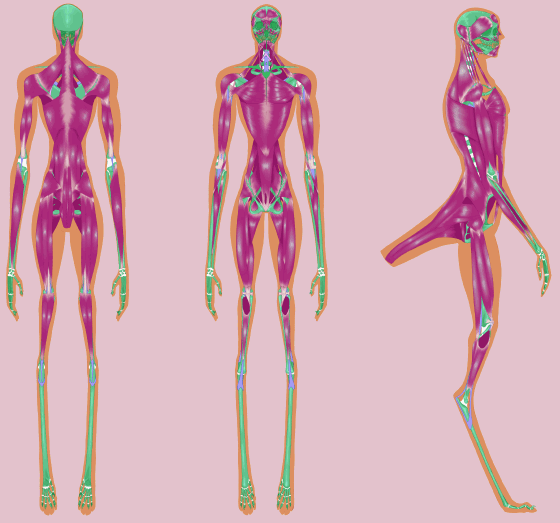
-Internal Anatomy-
Stormbird musculature and skeletal structure are fairly normal for most vertebrates until you reach the torso and overall body cavity.
The chest is scant of organs, mainly composed of their avian respiratory system accompanied by an additional filter and their core alongside the trachea and esophagus.
-Muscle-
muscles tend to have a metallic sheen and are richer in minerals than most biological muscles. Slightly conductive even when drained of blood, making them easy to hook up to prosthetics.
THE CORE

A finely shaped crystalline mass, Starting out as a small shard containing basic functions it grows overtime, the consumption of materials nourishing it and providing the materials to build layers to itself. Alongside to storing memories and overall information it generates and filters a Stormbird's blood, taking what it needs and sending it back out anew. As long as a Stormbird has its core it can regenerate its wounds and function as normal.
Without being properly cultivated a core can become brittle and potentially shatter leading to death.
the core functions as a mix of both the heart and the brain. it works much like a computer chip, storing information along its many edges and infinitesimal patterns and formations.
GUTS/STUFFING

lacking any real intestines stormbirds break down their food into its base components within their stomach where it is then churned into their internal stuffing. Stuffing is the equivalent of fat stores for stormbirds, said to have the texture of fluffy slime or foam. arteries will snake through and absorb nutrients or where it can be augmented into new body parts or organs at a whim.
BLOOD/HAEMOLYMPH

Blood makeup is a form of purified energy generated by their core. Excess energy in the blood can be expelled in a form of magic, spilled blood has restorative/healing/stimulating properties with whatever absorbs it. This property can be done simply from an extended presence for some, leading to many taking up agricultural professions.
Can be composed of most colors that are bright
dark colors are signifiers of genetic illness or defects, they can simply be a mutation as well.it has an oddly sweet flavor akin to nectar or sugar water with a tinge of electricity.
LUMINESCENCE

A byproduct of their blood is that it produces luminescence. Stormbirds have evolved pigment cells akin to cromataphors that collect the luminescent chemicals and some blood. These create identifying patterns that can be manually activated and deactivated. These cells are also present in specialized feathers [a type of blood feather] that contains a hydraulic vein that allows blood to be present in the quick to activate the cells in feather fibers.
The bio-luminescence is an evolutionary adaptation that allows them to better hunt in their home world environment that is rick with both bio-luminescence and biofluorescence. Working akin to counter illumination
The light cells are also able to be extracted and turned into a type of ink that some use to add to their preexisting patterns in the form of an interactive tattoo.
On their own though luminescence serves a few functions, such as being used in a mating display[identifying whether one is a doe or a stag] or as a health signifier. Its also able to be used as a lure for prey, as a way point when traveling in a group and it can also be used in a defensive way to startle and distract attackers. In modern day theres a sub-language thats used to send vague messages over a distance such as directions or potential threats.
MOUTH

-transcription-
-
Mouth glow evident in darker areas (see bioluminescence)
-
Hollow geode-like space used to adjust pressure.
-
Filled with a wet mesh that allows air pressure to be measured and accounted for, also doubling as a sort of barometer.
-
Stormbirds have stone teeth that have seven main variants.
-
Sapphire, Chrysoberyl, Corundum, Diorite, Granite, Feldspar, Topaz
-
These stones are marbled with the same mineral deposits put into their bones.
-
Jacobson's organ is located on the roof of the mouth.
-
Retracted beak.
-
When the beak is retracted it gives the impression of a large gap when the mouth is open.
-
Blood Flow inside of the teeth gives them a mild glow.
-
The tip is rougher for a bit of grip.
-
Long tongues. Neck muscles will flex when extended fully.
-
Capable of opening their mouth to a wider angle than a human.
-
Jaw strength is powerful enough to crack bone. Useful for eating large prey or disabling attackers.



the mandibles/jaws are incredibly mobile providing ease in consuming and attacking prey.


teeth are made of a single plate and are made of the same material as their bones

metal desposits are present at the cutting edge

the upper break serves as the roof of the mouth. the mouth is fashioned in a way to best swallow food along side their airways

the beak is retractable and a strong as a tongue
TOUNGE

the slit in the tongue is the area where wax is secreted to apply to feathers. it can also function as a proboscis.
SILK GLANDS

EARS


alongside the ears antennas are also present on the head. Works as a sensory organ capable of picking up touch, air currents/changes, heat, vibrations, some taste, and especially smells or hormones.
Aside from giving them a keen idea on their surroundings they also help them keep track of their position while in flight. The presence of other artimesians, and scent markings and territories.
Ironically enough some will tune out this sensory information in order to keep focused often leading to some being quite oblivious.
TAILS





EYES AND ANTENNA

-Transcription-
Uv light notes:
Artimesians can see in the normal human range as well as UV light
Uv light eyes are tetrachromatic (4cones).
pupils are slitted: less UV light perceived, looks close to human color range
Pupils round/wide/large/dilated: able to pick out things in UV light clearly
Things under uv light can:
Absorb light (appear darker)
Reflect light (appear brighter/glow)
Be neutral to light(appear lighter)
Or alter the original color
Noticeable things that appear in UV light:
Biological stains: saliva, semen, urine, and blood
Many things in nature, such as pollen and insects’ eyes, will glow in different colors when hit with UV light
Veins (UV light, surrounding areas usually somewhat UV dark)
Plant veins also very visible - chlorophyll appears reddish
White reflects most light including UV light making it glow
Invisible patterns, ie: Blaschko lines, flower landing patterns, scars(UV darker) sunscreen or other UV absorbing material, various detergents, stains of body fluid
Uv light stand-ins (colors for the invisible)
Blue, green, yellow, orange, red, purple, indigo

-transcription-
Artistic representation of smells/ olfactory sense of an stormbird
General environment view, normal colors in B&W for ease of viewing
Visuals are of: turbulence, scent, body fluids(blood), and pollen

-transcription-
Human with perfume
Stronger body smells show up in slightly off colors, unnatural added smells appear in other colors
Strong scents are highlighted with lighter colors within in it
Strong scents can override others, such as flower nectar or blood
ORGANS


the liver/stomach/kidneys
the lungs/syrinx
the syrinx when used by itself, can produce bird-like chirps, screeches, calls, and tinny mimicry of most sounds. partnered with mouth movement they can communicate in complex spoken language like other humanoid races and enhance their mimicry abilities. the resonance chamber is what allows them to make their unique thundering booms that they've aquired their name from.
the three main components of their robust digestive system. as stated before they can process just about anything. their stomach is eqquiped with extremely acidic bile that accompanied with the churing of their digestion pattern breaks down materials rapidly. pure componets mixed with fats and oils are excreted directly from the stomach while fluids and more complex chemicals are filtered through their large liver as well as their kidneys before being excreted in their purest and most protected forms.

HYDRAULIC POCKETS
pictured in purple in the initial diagram
unlike earth mammals a stormbirds strength is derived from hydraulic pressure instead of muscle. their muscles do server a purpose however, they're used to direct more fluid movements as well as being the main force that directs the fluid in its use. the fluid inside of these pockets is primarily haemolymph but a more watered down variant.
MUSCLES AND SKELETON

stormbird bones are composed of a mix of stone minerals and metal alloys. while typically this would make them too dense to fly their bones are hollow, and constructed more like a complex mesh inside as it has no need for bone marrow.
NERVOUS SYSTEM

a stormbirds nervous system is primarily composed of pseudo neurons packed tightly in important areas. these neurons monitor and control the body. particularly its finer motor skills and autonomous functions.
HANDS


FEET


WING SHIFTING

-transcription-
Wings are shifted in along the back. Due to their size, most stormbirds stick to having them out when necessary instead of having them all the time.
Along with standard wings, the butterfly-style wing is also popular. Structured similarly to a bat’s in connection, these wings can double as a kind of cape.

